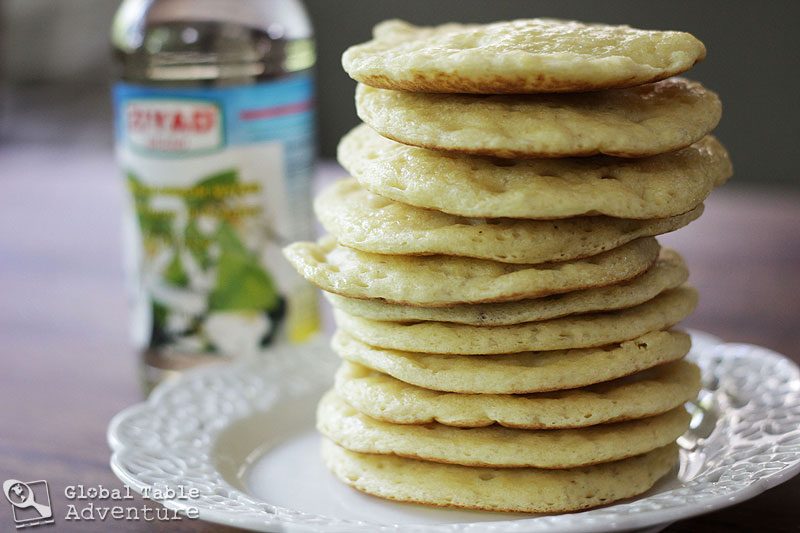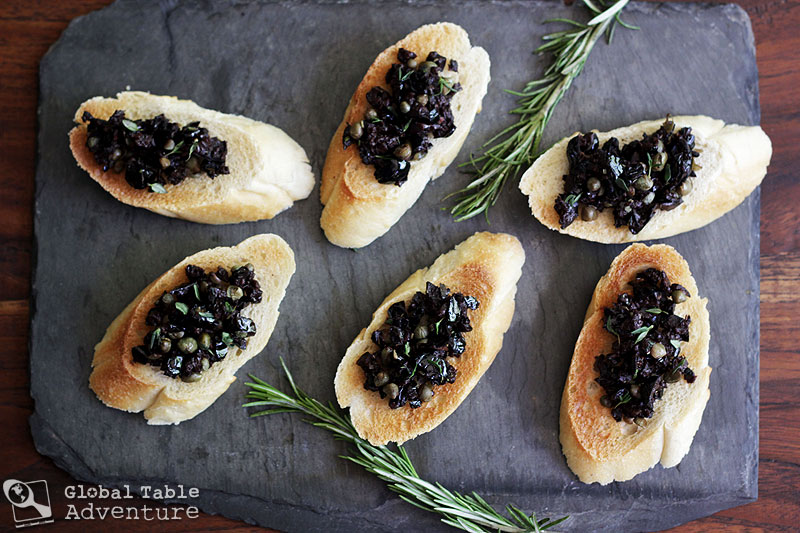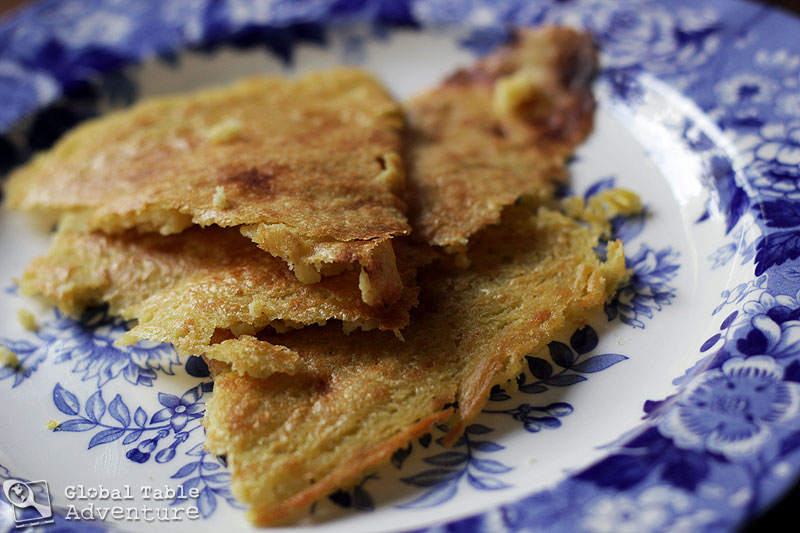Oh, goodness. Where do I even begin? Do you see that honey dripping off the edge of the crater cakes? Each drop is perfumed with the haunting aroma of orange blossom water and butter. Hello. I mean, really. I’m pretty sure I can just pack up and go home now. My job is done. Talk about good-glorious-eats! But, for those few who aren’t yet sure if this Moroccan treat – officially called Beghrir – is right for their breakfast table, let me continue. These semolina pancakes aren’t really pancakes. They are fried on one side only. The other side is utterly soft and yeasty, and pocked with thousands of holes. The bottom is crispy, while the top is light and airy. They’re like a crumpet’s long lost cousin. The holes are perfect for catching pools of orange blossom honey sauce, by the way. While some like them almost as thin as crepes and as large as a dinner plate, you can also make them smaller and a bit on the thicker side, as I did. The choice is yours. For …
Read More
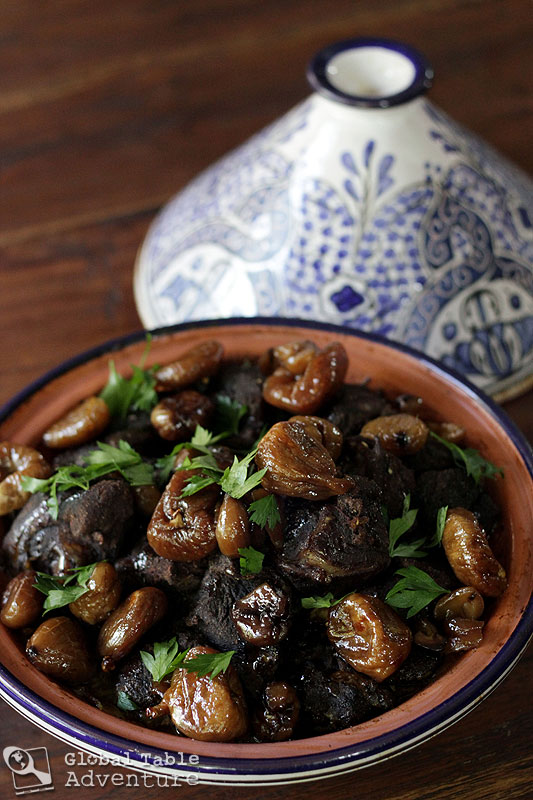
Today I’m taking you to a special place where family and friends gather around the dinner table with happy hearts. Silverware is optional, but bread is not. Settle into this sacred space, where tagine of lamb meets chestnuts, figs, cinnamon, honey, and orange blossom water. Pause for a moment to celebrate this crazy wonderful combination, to feel the hot air blow through your hair, then dig in and scoop up the glory with a handful of bread. When you’re done, cozy up to an evening of conversation so good you wish you could bottle it. Tagines are Moroccan party food – each nibble is filled with glorious, cheerful flavor; a festive bite of beauty; a deep, dark bowl of goodness, glimmering like the Moroccan night sky. To be honest, there was a time when the word “tagine” sent shivers down my spine. The very word sounded terribly exotic which, in my mind, translated to “extraordinarily difficult to make.” If I only knew how wrong I was. I’ve since learned that many Moroccan tagines, such as …
Read More

It only seems natural that we eat something black during our week at the Black Mountain (a.k.a Montenegro). But here’s the thing – nothing in life is black and white. There are all sorts of shades of gray (that’s where the beauty is – somewhere in the muddled middle). So, in the spirit of variety, we’re adding a few shades of gray to our pasta. We’ve got black pepper, white feta, and charcoal grey buckwheat noodles with a bit of sparkle from pools of golden olive oil. This is simple as can be and a fantastic chilled pasta salad for a hot summer’s day. And did I mention? It’s also gluten-free. You can buy buckwheat noodles (a.k.a. soba noodles) or make them yourself for a fun afternoon project. I tried this both ways and, while I loved the satisfaction of making the noodles myself, I also loved the easy, breezy simplicity of popping open a package of pre-made buckwheat noodles and having dinner on the table less than ten minutes later. NOTE: You can find buckwheat/soba noodles …
Read More
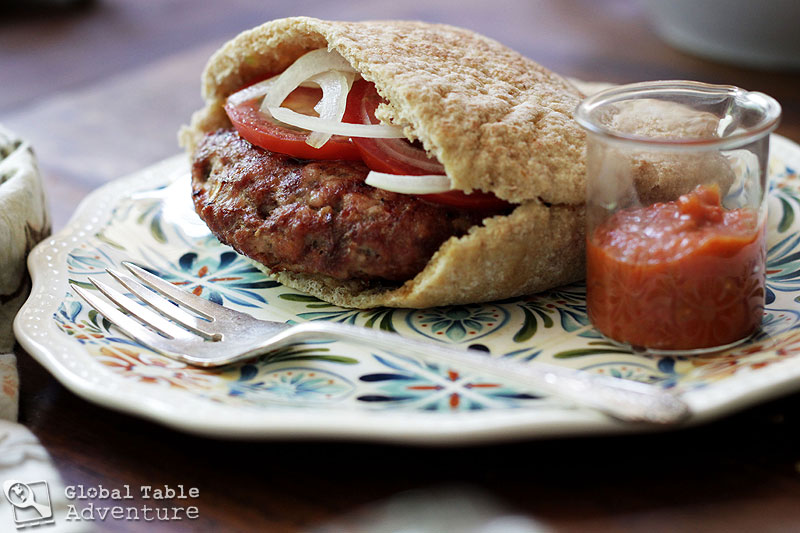
You don’t have to know how to pronounce it to enjoy eating it. Pljeskavica. If this long, meandering string of letters makes you stutter, just clap your hands, because that’s what Pljeskavica means – the sound of hands clapping as the “Balkan burger” patties are formed. And this is not just a big word. This is big food. This is the original “super-size.” Not only are the patties large enough to cover a small plate, they contain as many as 6 cuts of meat from three different animals. Everyone has their variation and you’ll typically find beef, lamb, and pork (for non-Muslims) in every bite. The entire animal is fair game. You can’t help but smile as your mouth stretches open with every bite. While each region (country, town, family, person!) has their own variation, most chow down on pljeskavica with a knife and fork. More recently, tucking the patty inside lepina, or thick pita bread with onion and tomato, is gaining popularity. Either way, don’t forget to slather each bite with roasted ajvar spread! For …
Read More
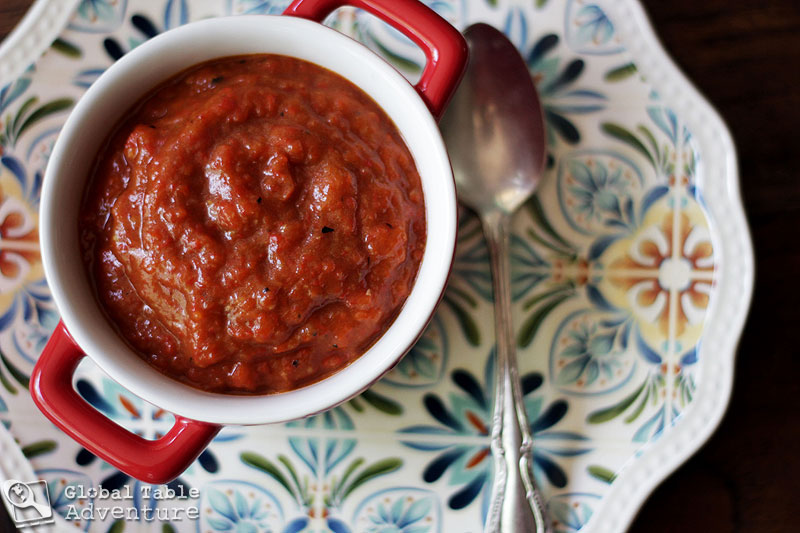
Some days I dream about reinventing myself – pulling myself up, out of the ordinary into the wildly wonderful. On these ornery-sorts-of-days, I imagine myself strutting around in a bold color I’ve never worn before, like mustard yellow. On really good days I actually make these dreams happen. I become a mustard-wearing queen. Other days I just end up wearing mustard. Literally. That’s the way life goes: sometimes change works, sometimes it doesn’t. The fun is in the trying. Are you willing to reinvent yourself – even just a little? What about your eating habits? Today, in the spirit of trying something new, we’re going to reinvent our ketchup eating habits. Here’s how it’s going to work: instead of slathering our food with globs and globs of ketchup, we’re going to be bold, sassy, and totally Balkan. We’re going to slather it in Ajvar. Ajvar is a pepper spread popular all over the Balkans. Typically made with fresh, roasted paprika peppers and (sometimes) eggplant, the bright garden flavor goes great with all manner of meat, especially burgers. The versatile …
Read More
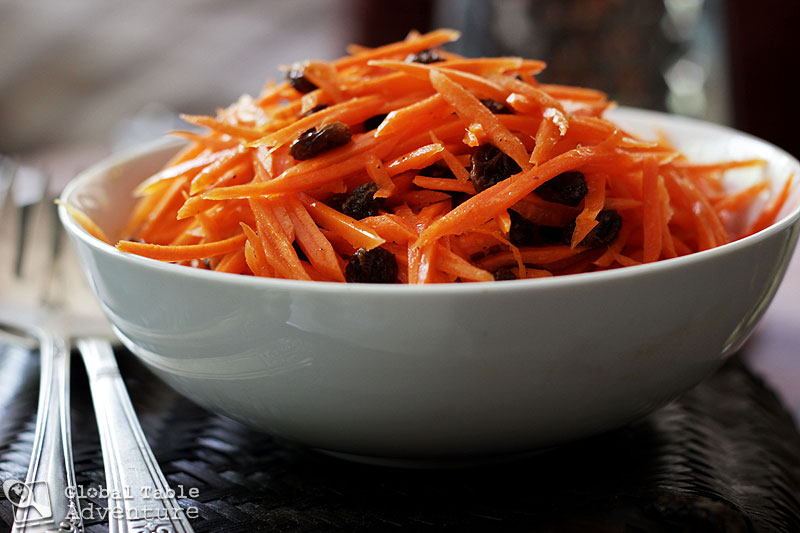
In Mongolia, the seemingly endless parade of meat, meat, and more meat, is only occasionally interrupted by vegetables. And, even then, relief doesn’t come with a garden salad, but rather some combination of root vegetables. This is because there really isn’t a whole lot of good farmland in the giant, cold, central Asian country – only the hardiest specimens make it. In the big city, versions of this simple carrot salad can be found, either dressed in a vinaigrette (as I have done) or in a mayonnaise/sour cream based dressing. So head to the market with me, and let’s stove top travel over to Mongolia! (Can you find the carrots in this picture?) Serves 4-6 Ingredients: 1 lb carrots, grated or julienned (on a mandolin is easiest) 1/2 cup raisins, soaked in hot water For the dressing: 1 large clove of garlic, grated 3 tablespoons vegetable oil 2 tablespoons white wine vinegar 1 1/2 teaspoons of sugar salt & pepper, to taste (be sure to use plenty of salt to bring out the flavors) Method: After picking up some …
Read More
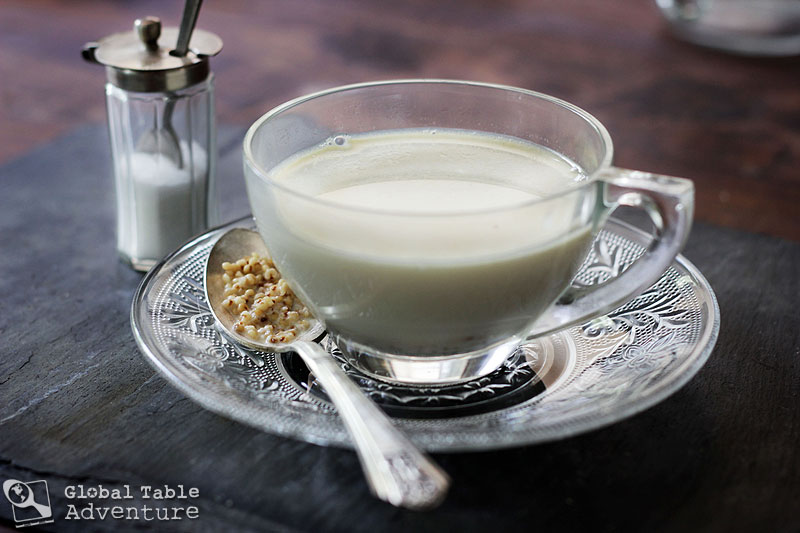
If tea time in your home means sweet, sugary cups of deliciousness, think again. This week we’re sipping on salty, milky green tea cooked with buttery toasted millet. This is one of the more elaborate versions of Suutei Tsai – a famous Mongolian drink enjoyed out on the cold steppes. Each sip tastes of milk and salt and cereal – but the drink also has a remarkable drying effect in the mouth, thanks to a healthy dose of naturally astringent green tea. This is absolutely the strangest tea I have ever sipped. But Suutei Tsai is also delightful – it just begs to be sipped under the starlight on a frosty winter evening. Or perhaps on a chilly spring day, while watching wild horses gallop through the horizon. Everything written about Suutei Tsai claims that westerners have trouble enjoying this drink. I find, however, that if you go into it expecting hot, milky cereal you’ll be alright. In other words, don’t expect sweet tea. Just forget about sugar entirely. And pass the salt. httpv://www.youtube.com/watch?v=o-Gfl4Agf-A&feature=player_embedded …
Read More
Introducing the black diamond of Monaco: Tapenade. She glitters in the night. She belies the briny bite of the absolutely fabulous. But here’s the thing. She’s also, not so secretly, rustic. This dip and crostini topper has its origins in the grassy hills of Provence. Love for this treat spills over into Monaco and parts of Italy. While many people pulverize their blend to a paste (with a mortar and pestle or even a food processor), I prefer a rustic, coarse mixture. I like seeing the capers and slices of olives. I like seeing bits of herbs. So all I do is run my knife through the ingredients a few times. The choice is yours but, either way, this mixture tastes grand – dressed up with cognac, capers, and a sprinkling of rosemary and thyme. Serve at the beginning of your next garden party, on crusty, toasted baguette, spread on crackers, with cheese as an hors d’ouvre. And be sure to raise a glass to Provence and even sunny Monaco. Ingredients: 1/4 cup capers 2-4 anchovy …
Read More
I am ready for a day-dreamy sort of day. One where I walk along the pier and smell the salty, ocean air… On this easy-breezy day I’ll nibble bits of crispy socca – an olive oil and chickpea based crêpe popular along the riviera. On this day I do not stumble. I do not stain my shirt. Nothing I say sounds silly and I’m free of heartache. Yes, there are days when a crêpe can do this for you… …especially if enjoyed in glitzy Monaco, with diamonds on the soles of your shoes. The bonus? This recipe is gluten-free. While the gluten-free craze has infiltrated popular culture, there are some segments of the world that have eaten this way for generations. Mostly thanks to dishes like socca. Along the Mediterranean coast socca is the go-to street food, enjoyed hot, out of hand, while walking around, listening to the the caw of gulls. While laughing. While smiling at the clouds bumble by. I shared this treat with my friend who’d recently been to Sicily, where he said he …
Read More
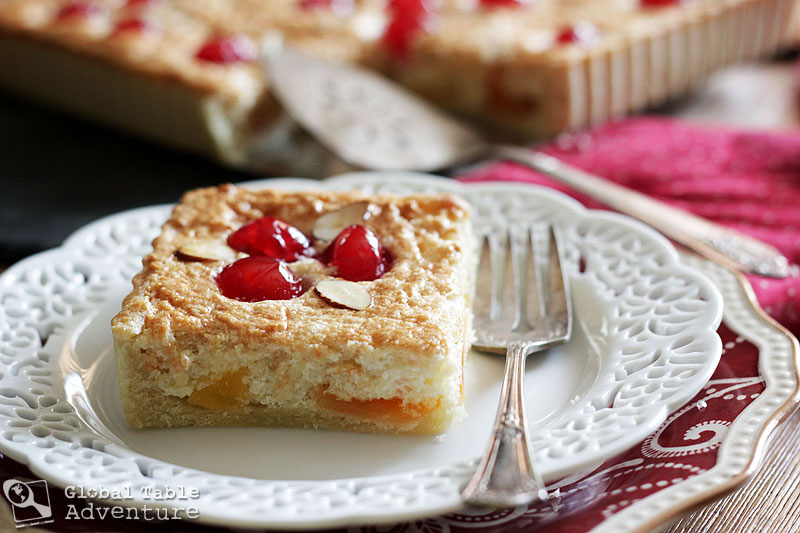
. Very rarely does a dessert glisten as brilliantly as the Galapian. She’s like unlike anything I’ve ever tasted before – slices of candied cantaloupe enrobed with a light almond cake, studded with brilliant maraschino cherry drops and glazed with lavender honey. . This movie star of a dessert was invented in 1994 by Alain Bouchard in Apt, a region of France near to Monaco. While a relatively new invention, it has all the glitz and glamour that is so enjoyed by the Monégasque. . While relatively easy to prepare, this dessert brings even the fussiest gourmands to their knees. Try it for a bridal or baby shower, or maybe just an afternoon sitting by the shore, sipping sweet muscat wine (as recommended by Bouchard). . Instant glamour. . Absolutely Fabulous. Inspired the World Cookbook for Students. . Ingredients: . Sweet Pastry Dough: . 1 cup flour 1/2 cup confectioner’s sugar 1/2 cup (8 Tbsp) butter, chilled 1/4 cup slivered almonds, measured then ground in a spice mill 1 egg . Fruit & Almond Filling: . 4 egg whites …
Read More

I’ve done it standing in front of my refrigerator at midnight. I’ve done it at 8:30 in the morning, right after eating a complete breakfast. I’ve even done it in celebration of eating all my veggies. I fill my belly with bowlfuls of carbs – pasta, bread, potatoes, or rice – it really doesn’t matter. Simply put: I’m carb crazy. Enter Mamaliga, Moldova’s favorite side dish (and Romania’s, too). Carb-tastic. This thick, dense polenta is made with corn meal (the coarser the better), water, and a bit of butter to make it slip-slide out of the bowl you set it in. Traditionally Mamaliga is sliced into slabs with a string or fishing line. Traditionally, you’d serve it with sour cream and cheese, and it is much appreciated on the side of nearly any dish, especially the locally adored sour soups (like borscht [recipe]). So, friends, join me on the fast train to Moldova with Mamaliga. I’ll save you a seat. Serves 3-4 Ingredients: 3 cups of water 1 cup of yellow cornmeal (medium or coarse grind, …
Read More
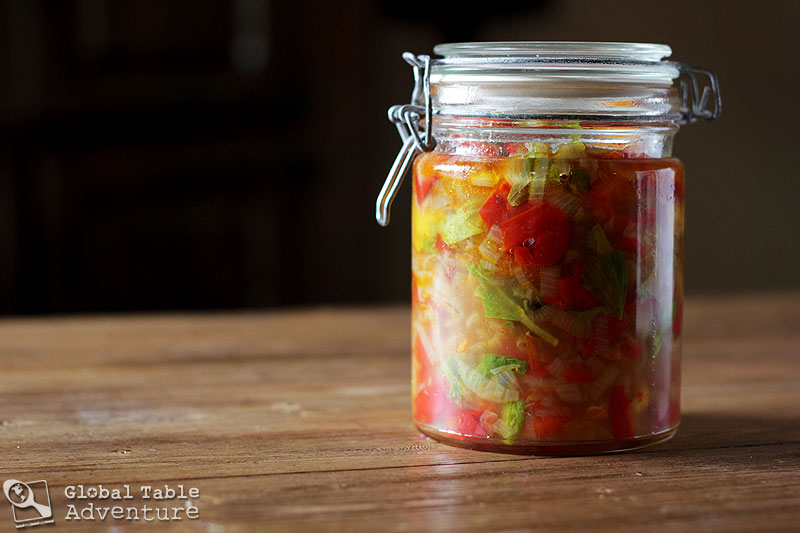
Logistically speaking, peppers make for really great dinners. They’re healthy. They’re big on sweet, juicy flavor. The don’t go bad quickly. And they go with nearly anything. But when you have a veggie garden, figuring out how to use up all your peppers can be a nightmare. Heck, even if you don’t garden it can be a challenge to take advantage of the fresh produce at the market (hello, sale prices!). Today, thanks to Moldova, we’re going to solve that. We’ve already had several great recipes on the blog, including Stuffed Peppers, Ratatouille, and Muhammara (the craziest roasted red pepper dip you’ve ever dipped). With today’s Moldovan Preserved Peppers you can jar your peppers and enjoy them all year round. They taste like sweet pepper sunshine covered in olive oil and a hint of vinegar. Pile it up on the side of your fish or even on top of a sandwich. In Moldova this recipe is typically made with peppers called “gogosari” which, according to Susan, a volunteer in the Peace Corps with an …
Read More

